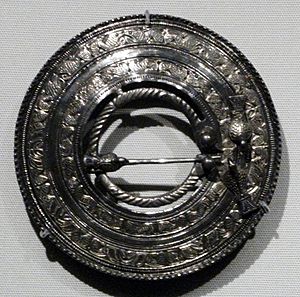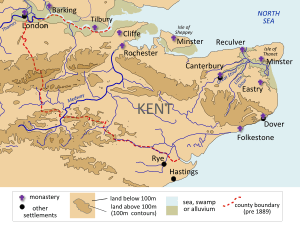Sarre Anglo-Saxon cemetery facts for kids

Sarre Anglo-Saxon cemetery is an ancient burial ground. People were buried here during the 500s and 600s CE. This time is known as the Anglo-Saxon period in England.
Contents
Understanding Anglo-Saxon Kent
The Anglo-Saxon period began in the 400s CE. The area we now call Kent changed a lot during this time. Before, it was part of the Roman Empire. It was known as the civitas of Cantiaci. This was a Roman administrative area.
After Roman rule ended around 410 CE, Roman ways of life slowly disappeared. New Anglo-Saxon customs and traditions took their place. Old stories say that tribes from northern Europe came to Britain. These tribes included the Angles, Saxons, and Jutes.
However, archaeologists have found that Anglo-Saxon culture mixed with the existing Romano-British culture. This mixing is called syncretism. It means that new and old ideas blended together.
The Kingdom of Kent
The name Kent first appeared during the Anglo-Saxon period. It came from an older Celtic name, Cantii. At first, it only referred to the area east of the River Medway. By the late 500s, it included areas to the west as well.
The Kingdom of Kent was one of the first Anglo-Saxon kingdoms. It became very powerful by the end of the 500s. Kent controlled large parts of southern and eastern Britain. It also had strong trade links with a region called Francia (modern-day France).
The royal family of Kent even married members of Francia's Merovingian dynasty. These French royals were already Christian. Kentish King Æthelberht was a powerful ruler. He became Christian in the early 600s. This happened because of Augustine of Canterbury. He was sent by Pope Gregory to spread Christianity. Augustine's mission helped replace old pagan beliefs with Christianity in England. The Sarre cemetery was used during this important time.
Studying Ancient Burials
Kent has many ancient burial sites from the Early Medieval period. The first excavations of Anglo-Saxon graves in Kent happened in the 1600s. People who studied old things, called antiquarians, became very interested in these remains.
Over the years, this interest grew into more scientific archaeology. Famous archaeologists like Bryan Faussett and James Douglas studied Kent's ancient sites. Their work helped us learn a lot about the past.
Discovering Sarre Cemetery
Early antiquarians did not know about the Sarre cemetery. It was first found in 1843. Then, in 1860, more artifacts were found during construction work. These items were bought by the British Museum.
In 1863, the Kent Archaeological Society excavated the site. John Brent led this project. He published his findings in a journal called Archaeologia Cantiana. Brent and two workers used a metal probe to find the graves.
After this excavation, people thought the entire cemetery had been explored. It was considered one of the richest Anglo-Saxon burial grounds ever found. However, it was not officially protected as an Ancient Monument.
Later Discoveries
In 1982, D.R.J. Perkins led another excavation. They were looking for the site of St. Giles. Instead, they found more Anglo-Saxon graves. These graves were about 50 meters away from where Brent had dug.
This discovery made Perkins look at the old cemetery map again. He also took aerial photos of the area. The photos showed that the cemetery was much larger than previously thought. It had features that Brent's team had missed.
Because of this, more excavations were planned. The landowners, Church Commissioners, and a local farmer, Michael Baxter, all helped. In May 1991, Southern Water started a sewage project nearby. This led to a "rescue excavation" by the Trust for Thanet Archaeology. They worked to save any historical items before construction continued.


